Analysis of the Componential Model of Creative Performance
VerifiedAdded on 2020/05/11
|5
|1172
|392
Essay
AI Summary
This essay delves into the componential model of creative performance, a framework that outlines the cognitive and social elements essential for generating creative output. The model, applicable across academic and corporate settings, defines creativity as the production of novel, appropriate, and useful ideas. It identifies four key components: domain-relevant skills, creative thinking skills, intrinsic task motivation, and the social environment. Domain-relevant skills encompass knowledge, expertise, and technical abilities in a specific field, while creative thinking skills involve cognitive processes like problem-solving and novel idea generation. Intrinsic motivation, driven by passion and interest, is emphasized as crucial, alongside the influence of the social environment in fostering or hindering creativity. The essay further suggests integrating this model into science education to enhance student creativity, emphasizing the importance of building domain knowledge, encouraging creative thinking through hypothesis development, and fostering a supportive social environment that values innovation and brainstorming. The conclusion highlights the synergistic effect of these components in achieving the highest levels of creativity.
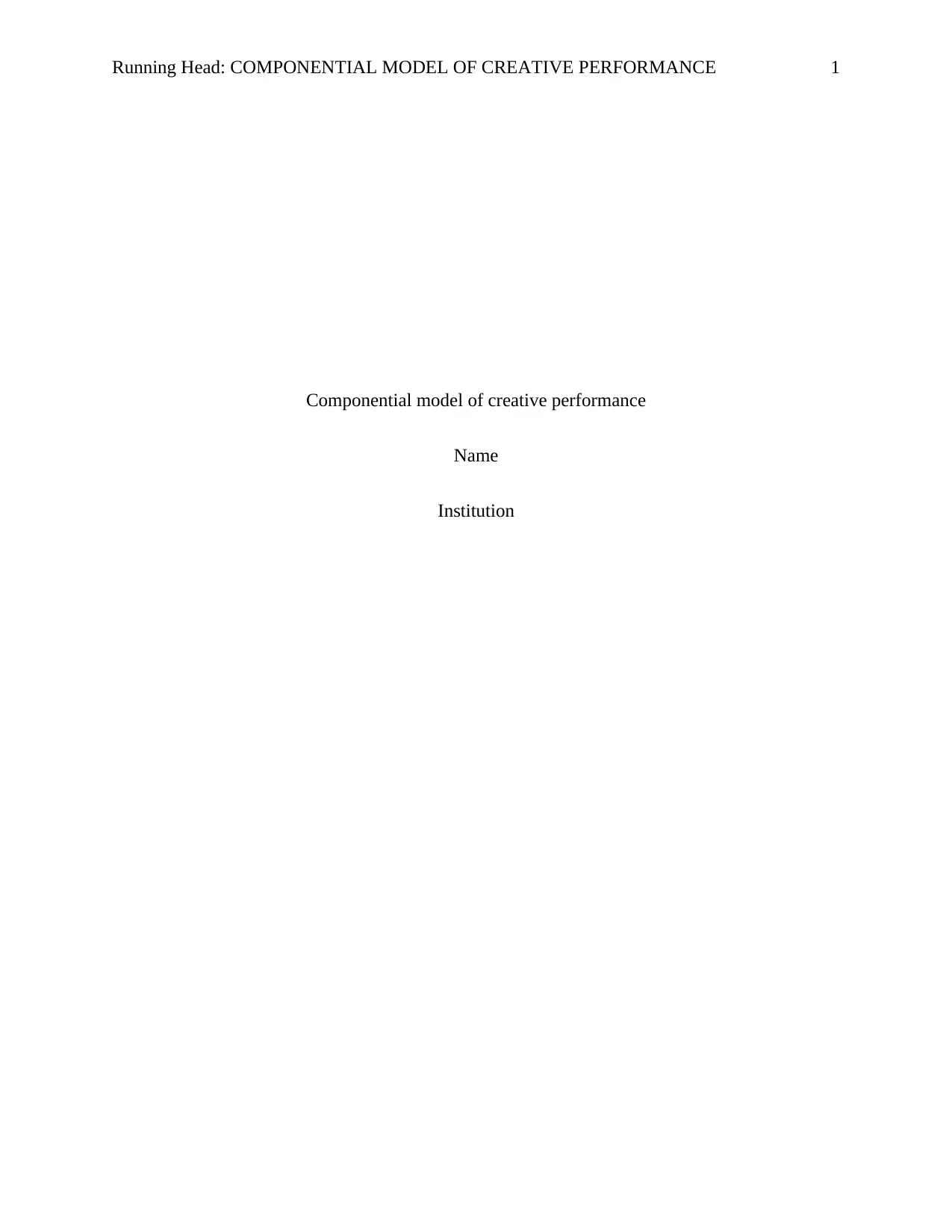
Running Head: COMPONENTIAL MODEL OF CREATIVE PERFORMANCE 1
Componential model of creative performance
Name
Institution
Componential model of creative performance
Name
Institution
Paraphrase This Document
Need a fresh take? Get an instant paraphrase of this document with our AI Paraphraser
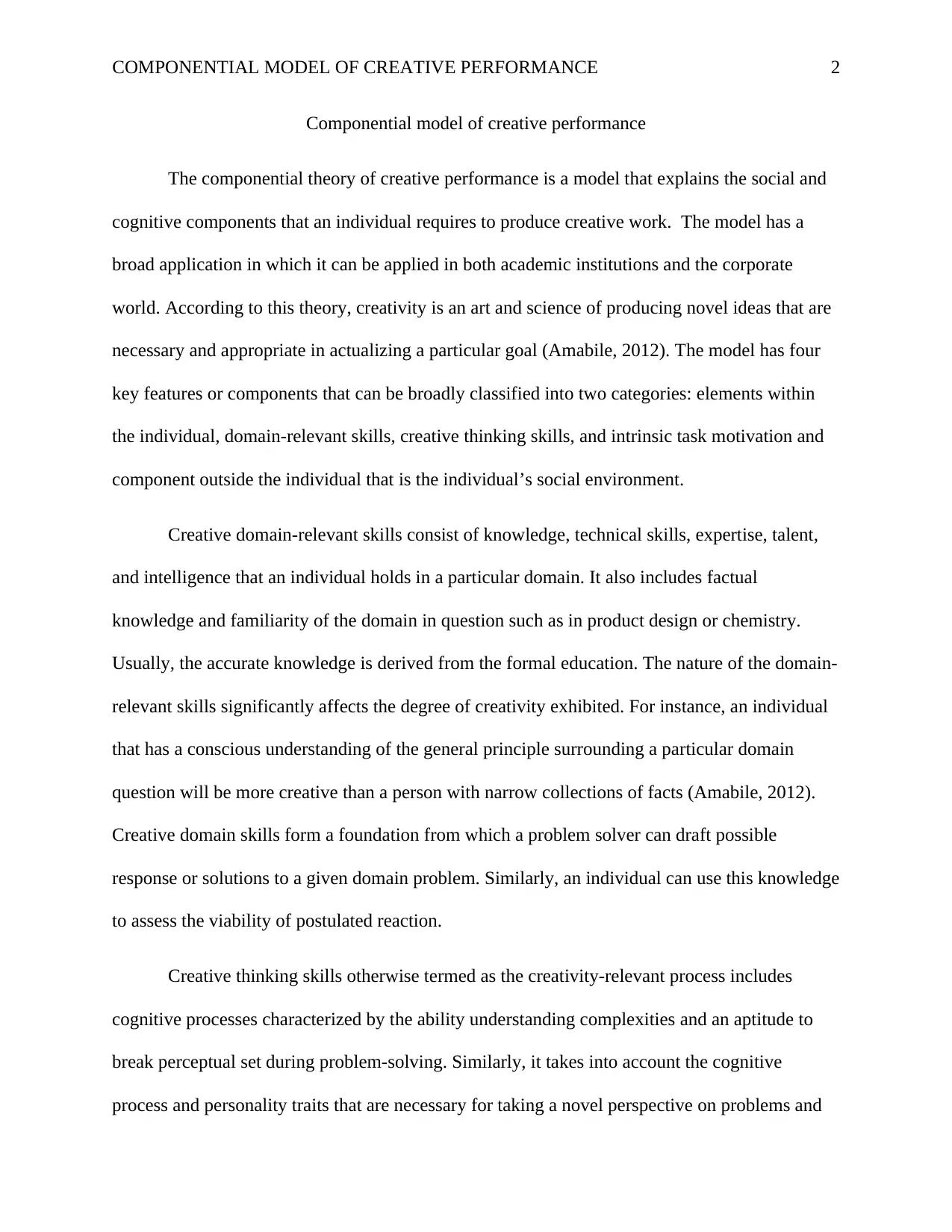
COMPONENTIAL MODEL OF CREATIVE PERFORMANCE 2
Componential model of creative performance
The componential theory of creative performance is a model that explains the social and
cognitive components that an individual requires to produce creative work. The model has a
broad application in which it can be applied in both academic institutions and the corporate
world. According to this theory, creativity is an art and science of producing novel ideas that are
necessary and appropriate in actualizing a particular goal (Amabile, 2012). The model has four
key features or components that can be broadly classified into two categories: elements within
the individual, domain-relevant skills, creative thinking skills, and intrinsic task motivation and
component outside the individual that is the individual’s social environment.
Creative domain-relevant skills consist of knowledge, technical skills, expertise, talent,
and intelligence that an individual holds in a particular domain. It also includes factual
knowledge and familiarity of the domain in question such as in product design or chemistry.
Usually, the accurate knowledge is derived from the formal education. The nature of the domain-
relevant skills significantly affects the degree of creativity exhibited. For instance, an individual
that has a conscious understanding of the general principle surrounding a particular domain
question will be more creative than a person with narrow collections of facts (Amabile, 2012).
Creative domain skills form a foundation from which a problem solver can draft possible
response or solutions to a given domain problem. Similarly, an individual can use this knowledge
to assess the viability of postulated reaction.
Creative thinking skills otherwise termed as the creativity-relevant process includes
cognitive processes characterized by the ability understanding complexities and an aptitude to
break perceptual set during problem-solving. Similarly, it takes into account the cognitive
process and personality traits that are necessary for taking a novel perspective on problems and
Componential model of creative performance
The componential theory of creative performance is a model that explains the social and
cognitive components that an individual requires to produce creative work. The model has a
broad application in which it can be applied in both academic institutions and the corporate
world. According to this theory, creativity is an art and science of producing novel ideas that are
necessary and appropriate in actualizing a particular goal (Amabile, 2012). The model has four
key features or components that can be broadly classified into two categories: elements within
the individual, domain-relevant skills, creative thinking skills, and intrinsic task motivation and
component outside the individual that is the individual’s social environment.
Creative domain-relevant skills consist of knowledge, technical skills, expertise, talent,
and intelligence that an individual holds in a particular domain. It also includes factual
knowledge and familiarity of the domain in question such as in product design or chemistry.
Usually, the accurate knowledge is derived from the formal education. The nature of the domain-
relevant skills significantly affects the degree of creativity exhibited. For instance, an individual
that has a conscious understanding of the general principle surrounding a particular domain
question will be more creative than a person with narrow collections of facts (Amabile, 2012).
Creative domain skills form a foundation from which a problem solver can draft possible
response or solutions to a given domain problem. Similarly, an individual can use this knowledge
to assess the viability of postulated reaction.
Creative thinking skills otherwise termed as the creativity-relevant process includes
cognitive processes characterized by the ability understanding complexities and an aptitude to
break perceptual set during problem-solving. Similarly, it takes into account the cognitive
process and personality traits that are necessary for taking a novel perspective on problems and
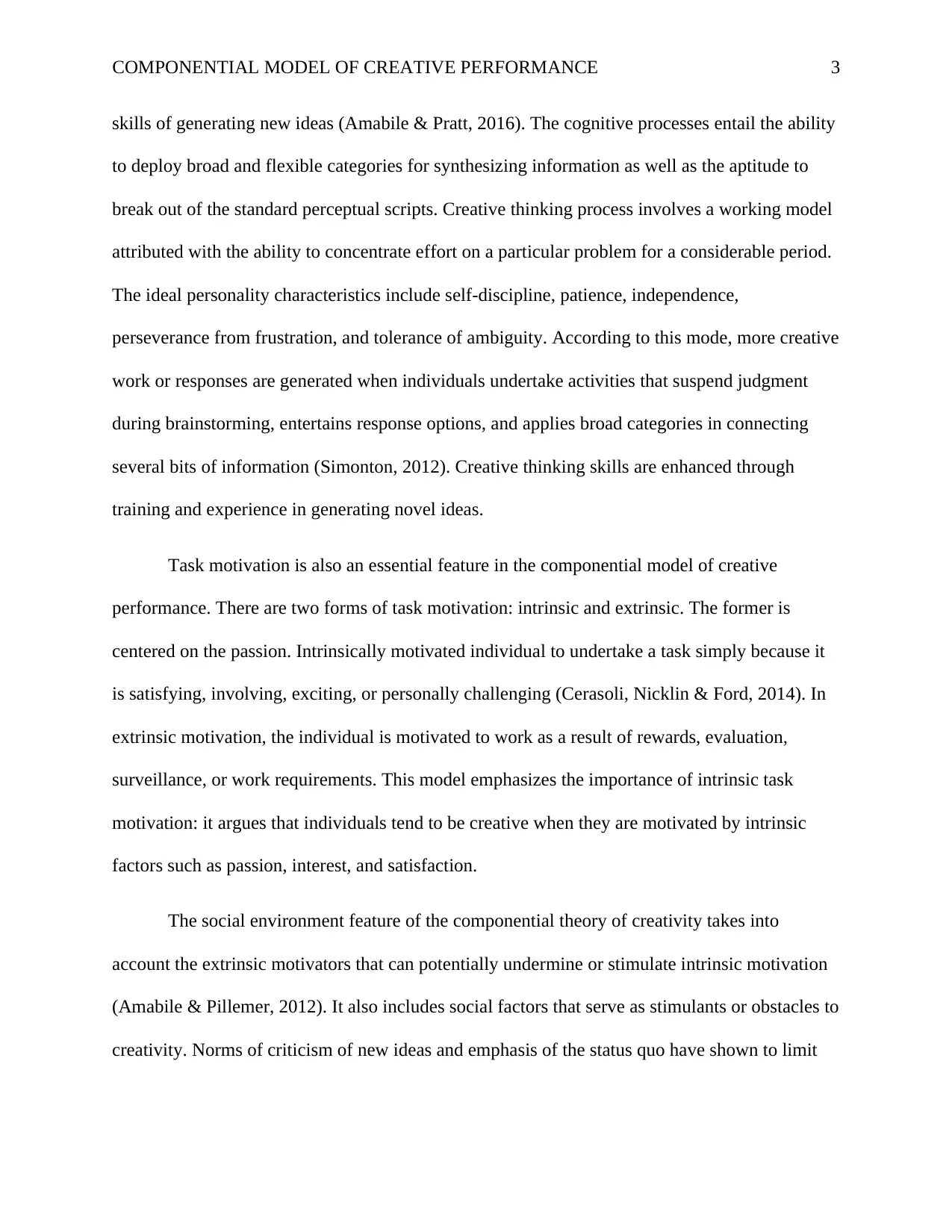
COMPONENTIAL MODEL OF CREATIVE PERFORMANCE 3
skills of generating new ideas (Amabile & Pratt, 2016). The cognitive processes entail the ability
to deploy broad and flexible categories for synthesizing information as well as the aptitude to
break out of the standard perceptual scripts. Creative thinking process involves a working model
attributed with the ability to concentrate effort on a particular problem for a considerable period.
The ideal personality characteristics include self-discipline, patience, independence,
perseverance from frustration, and tolerance of ambiguity. According to this mode, more creative
work or responses are generated when individuals undertake activities that suspend judgment
during brainstorming, entertains response options, and applies broad categories in connecting
several bits of information (Simonton, 2012). Creative thinking skills are enhanced through
training and experience in generating novel ideas.
Task motivation is also an essential feature in the componential model of creative
performance. There are two forms of task motivation: intrinsic and extrinsic. The former is
centered on the passion. Intrinsically motivated individual to undertake a task simply because it
is satisfying, involving, exciting, or personally challenging (Cerasoli, Nicklin & Ford, 2014). In
extrinsic motivation, the individual is motivated to work as a result of rewards, evaluation,
surveillance, or work requirements. This model emphasizes the importance of intrinsic task
motivation: it argues that individuals tend to be creative when they are motivated by intrinsic
factors such as passion, interest, and satisfaction.
The social environment feature of the componential theory of creativity takes into
account the extrinsic motivators that can potentially undermine or stimulate intrinsic motivation
(Amabile & Pillemer, 2012). It also includes social factors that serve as stimulants or obstacles to
creativity. Norms of criticism of new ideas and emphasis of the status quo have shown to limit
skills of generating new ideas (Amabile & Pratt, 2016). The cognitive processes entail the ability
to deploy broad and flexible categories for synthesizing information as well as the aptitude to
break out of the standard perceptual scripts. Creative thinking process involves a working model
attributed with the ability to concentrate effort on a particular problem for a considerable period.
The ideal personality characteristics include self-discipline, patience, independence,
perseverance from frustration, and tolerance of ambiguity. According to this mode, more creative
work or responses are generated when individuals undertake activities that suspend judgment
during brainstorming, entertains response options, and applies broad categories in connecting
several bits of information (Simonton, 2012). Creative thinking skills are enhanced through
training and experience in generating novel ideas.
Task motivation is also an essential feature in the componential model of creative
performance. There are two forms of task motivation: intrinsic and extrinsic. The former is
centered on the passion. Intrinsically motivated individual to undertake a task simply because it
is satisfying, involving, exciting, or personally challenging (Cerasoli, Nicklin & Ford, 2014). In
extrinsic motivation, the individual is motivated to work as a result of rewards, evaluation,
surveillance, or work requirements. This model emphasizes the importance of intrinsic task
motivation: it argues that individuals tend to be creative when they are motivated by intrinsic
factors such as passion, interest, and satisfaction.
The social environment feature of the componential theory of creativity takes into
account the extrinsic motivators that can potentially undermine or stimulate intrinsic motivation
(Amabile & Pillemer, 2012). It also includes social factors that serve as stimulants or obstacles to
creativity. Norms of criticism of new ideas and emphasis of the status quo have shown to limit
⊘ This is a preview!⊘
Do you want full access?
Subscribe today to unlock all pages.

Trusted by 1+ million students worldwide
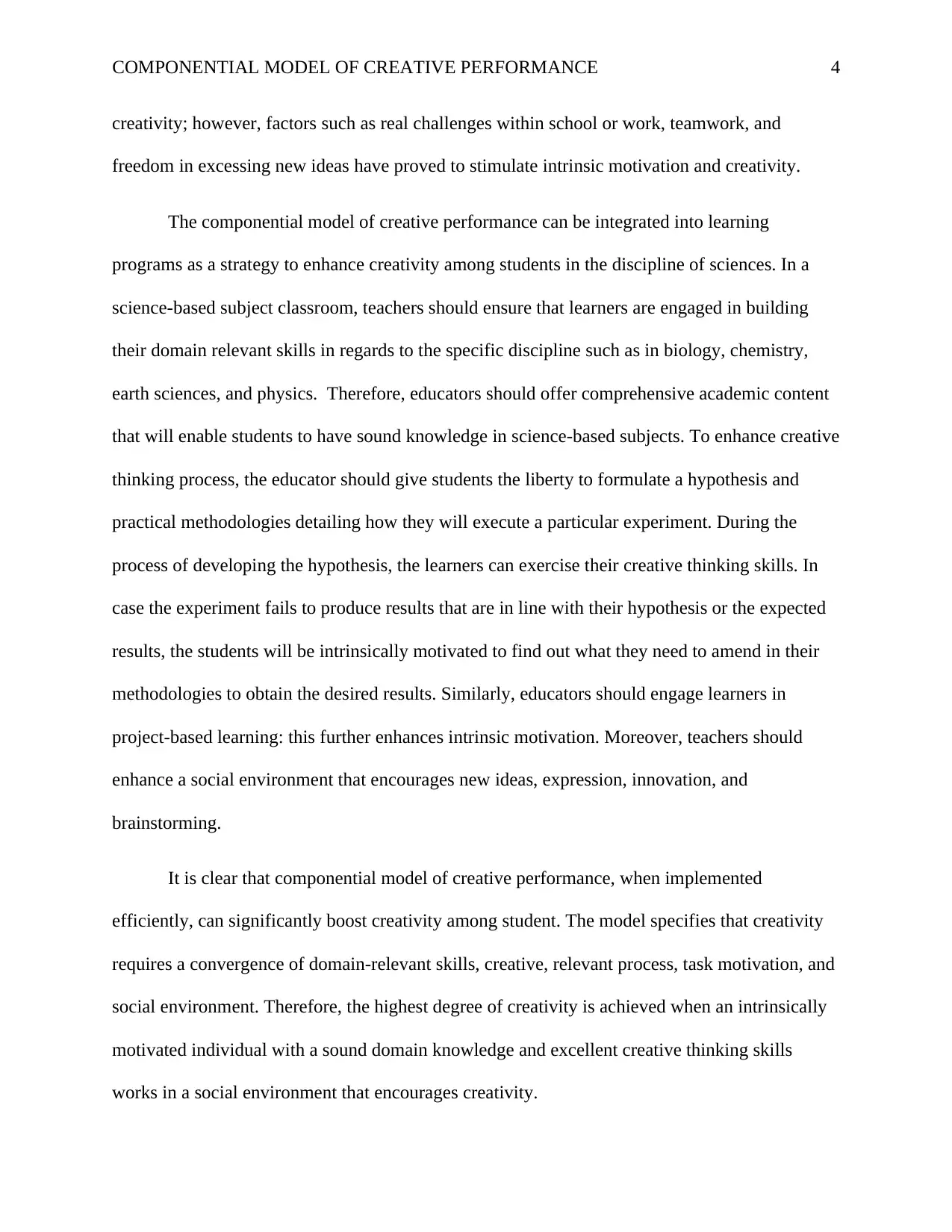
COMPONENTIAL MODEL OF CREATIVE PERFORMANCE 4
creativity; however, factors such as real challenges within school or work, teamwork, and
freedom in excessing new ideas have proved to stimulate intrinsic motivation and creativity.
The componential model of creative performance can be integrated into learning
programs as a strategy to enhance creativity among students in the discipline of sciences. In a
science-based subject classroom, teachers should ensure that learners are engaged in building
their domain relevant skills in regards to the specific discipline such as in biology, chemistry,
earth sciences, and physics. Therefore, educators should offer comprehensive academic content
that will enable students to have sound knowledge in science-based subjects. To enhance creative
thinking process, the educator should give students the liberty to formulate a hypothesis and
practical methodologies detailing how they will execute a particular experiment. During the
process of developing the hypothesis, the learners can exercise their creative thinking skills. In
case the experiment fails to produce results that are in line with their hypothesis or the expected
results, the students will be intrinsically motivated to find out what they need to amend in their
methodologies to obtain the desired results. Similarly, educators should engage learners in
project-based learning: this further enhances intrinsic motivation. Moreover, teachers should
enhance a social environment that encourages new ideas, expression, innovation, and
brainstorming.
It is clear that componential model of creative performance, when implemented
efficiently, can significantly boost creativity among student. The model specifies that creativity
requires a convergence of domain-relevant skills, creative, relevant process, task motivation, and
social environment. Therefore, the highest degree of creativity is achieved when an intrinsically
motivated individual with a sound domain knowledge and excellent creative thinking skills
works in a social environment that encourages creativity.
creativity; however, factors such as real challenges within school or work, teamwork, and
freedom in excessing new ideas have proved to stimulate intrinsic motivation and creativity.
The componential model of creative performance can be integrated into learning
programs as a strategy to enhance creativity among students in the discipline of sciences. In a
science-based subject classroom, teachers should ensure that learners are engaged in building
their domain relevant skills in regards to the specific discipline such as in biology, chemistry,
earth sciences, and physics. Therefore, educators should offer comprehensive academic content
that will enable students to have sound knowledge in science-based subjects. To enhance creative
thinking process, the educator should give students the liberty to formulate a hypothesis and
practical methodologies detailing how they will execute a particular experiment. During the
process of developing the hypothesis, the learners can exercise their creative thinking skills. In
case the experiment fails to produce results that are in line with their hypothesis or the expected
results, the students will be intrinsically motivated to find out what they need to amend in their
methodologies to obtain the desired results. Similarly, educators should engage learners in
project-based learning: this further enhances intrinsic motivation. Moreover, teachers should
enhance a social environment that encourages new ideas, expression, innovation, and
brainstorming.
It is clear that componential model of creative performance, when implemented
efficiently, can significantly boost creativity among student. The model specifies that creativity
requires a convergence of domain-relevant skills, creative, relevant process, task motivation, and
social environment. Therefore, the highest degree of creativity is achieved when an intrinsically
motivated individual with a sound domain knowledge and excellent creative thinking skills
works in a social environment that encourages creativity.
Paraphrase This Document
Need a fresh take? Get an instant paraphrase of this document with our AI Paraphraser
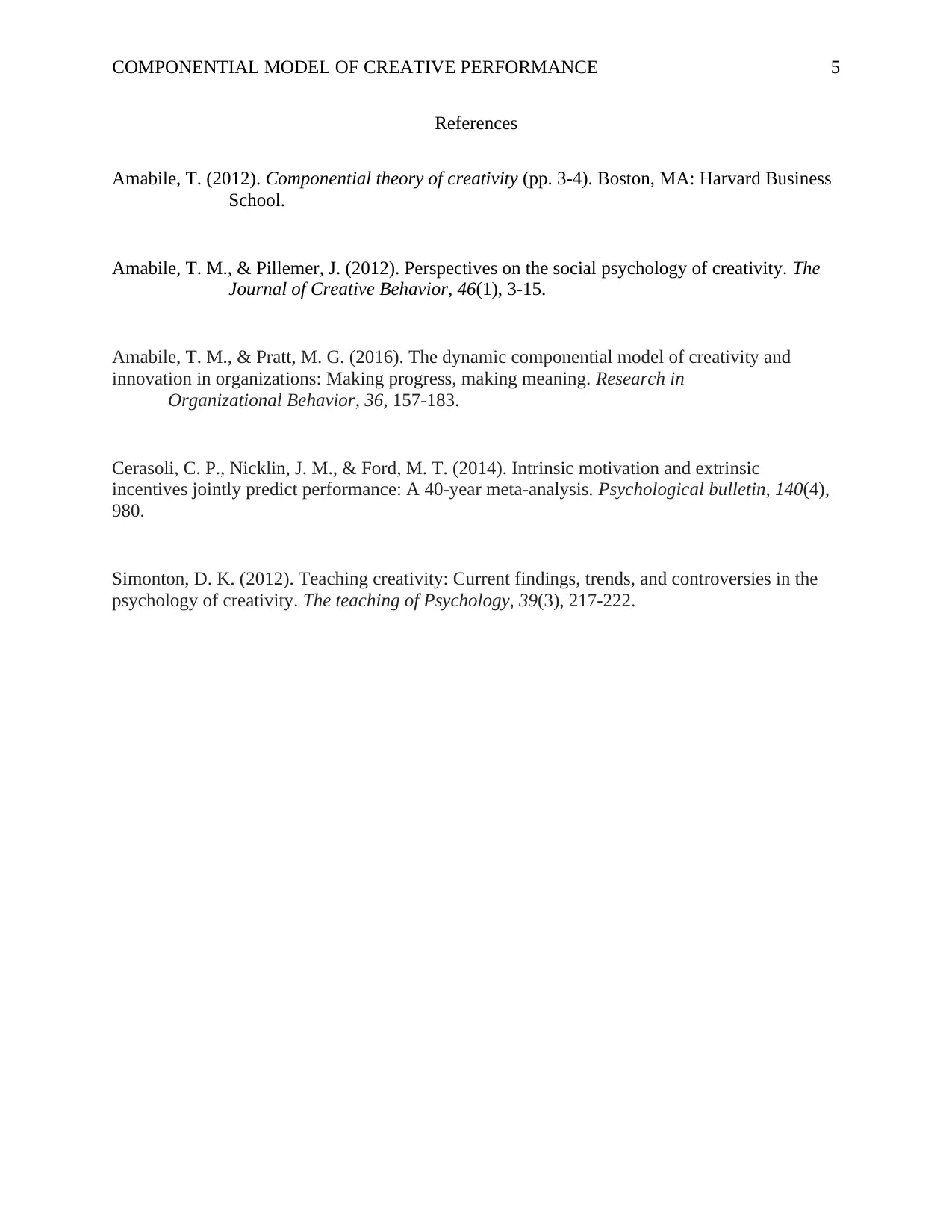
COMPONENTIAL MODEL OF CREATIVE PERFORMANCE 5
References
Amabile, T. (2012). Componential theory of creativity (pp. 3-4). Boston, MA: Harvard Business
School.
Amabile, T. M., & Pillemer, J. (2012). Perspectives on the social psychology of creativity. The
Journal of Creative Behavior, 46(1), 3-15.
Amabile, T. M., & Pratt, M. G. (2016). The dynamic componential model of creativity and
innovation in organizations: Making progress, making meaning. Research in
Organizational Behavior, 36, 157-183.
Cerasoli, C. P., Nicklin, J. M., & Ford, M. T. (2014). Intrinsic motivation and extrinsic
incentives jointly predict performance: A 40-year meta-analysis. Psychological bulletin, 140(4),
980.
Simonton, D. K. (2012). Teaching creativity: Current findings, trends, and controversies in the
psychology of creativity. The teaching of Psychology, 39(3), 217-222.
References
Amabile, T. (2012). Componential theory of creativity (pp. 3-4). Boston, MA: Harvard Business
School.
Amabile, T. M., & Pillemer, J. (2012). Perspectives on the social psychology of creativity. The
Journal of Creative Behavior, 46(1), 3-15.
Amabile, T. M., & Pratt, M. G. (2016). The dynamic componential model of creativity and
innovation in organizations: Making progress, making meaning. Research in
Organizational Behavior, 36, 157-183.
Cerasoli, C. P., Nicklin, J. M., & Ford, M. T. (2014). Intrinsic motivation and extrinsic
incentives jointly predict performance: A 40-year meta-analysis. Psychological bulletin, 140(4),
980.
Simonton, D. K. (2012). Teaching creativity: Current findings, trends, and controversies in the
psychology of creativity. The teaching of Psychology, 39(3), 217-222.
1 out of 5
Related Documents
Your All-in-One AI-Powered Toolkit for Academic Success.
+13062052269
info@desklib.com
Available 24*7 on WhatsApp / Email
![[object Object]](/_next/static/media/star-bottom.7253800d.svg)
Unlock your academic potential
Copyright © 2020–2025 A2Z Services. All Rights Reserved. Developed and managed by ZUCOL.




